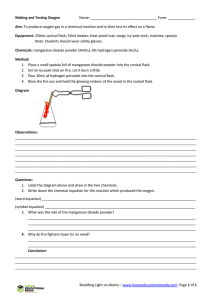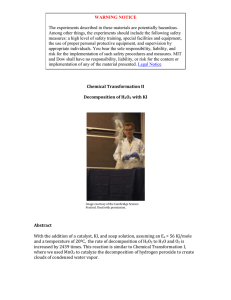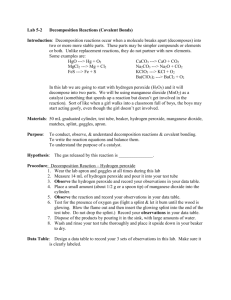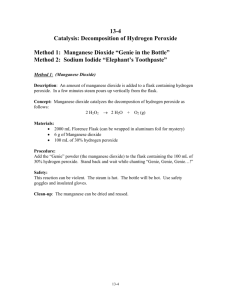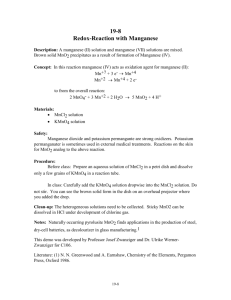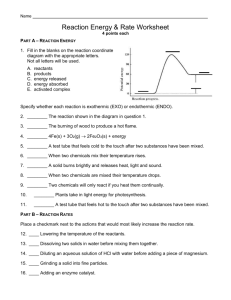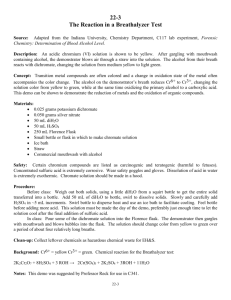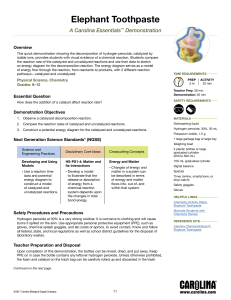The experiments described in these materials are potentially hazardous. WARNING NOTICE
advertisement
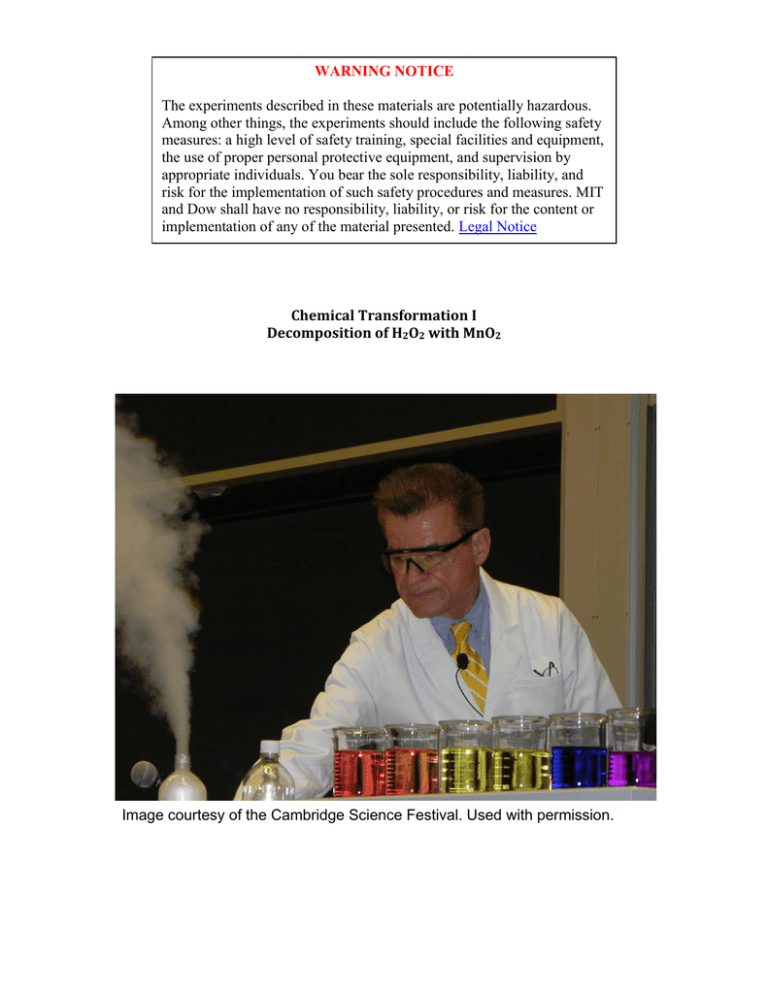
WARNING NOTICE The experiments described in these materials are potentially hazardous. Among other things, the experiments should include the following safety measures: a high level of safety training, special facilities and equipment, the use of proper personal protective equipment, and supervision by appropriate individuals. You bear the sole responsibility, liability, and risk for the implementation of such safety procedures and measures. MIT and Dow shall have no responsibility, liability, or risk for the content or implementation of any of the material presented. Legal Notice Chemical Transformation I Decomposition of H2O2 with MnO2 Image courtesy of the Cambridge Science Festival. Used with permission. Abstract With the addition of a naturally occuring catalyst, MnO2, and assuming an Ea = 58 KJ/mole and a temperature of 200C, the decomposition of H2O2 to H2O and O2 can be increased by 1073 times. Materials 2 Empty 2L bottles Reaction tray Gloves Spatula 30% Hydrogen Peroxide Manganese Dioxide Safety Glasses 100 mL Graduated Cylinder Safety 30% hydrogen peroxide is a strong oxidizer. Contact with any type of combustables may cause fire. Very corrosive to the eyes, nose, throat, skin and lungs. Always wear gloves and safety goggles when working with this material. Manganese dioxide is another strong oxidizer. Contact with other materials can cause fire. Harmful if inhaled and can harm lungs, central nervous system, blood and kidneys. Always handle this material carefully. Procedure Carefully pour out 50 mL of 30% hydrogen peroxide into a graduated cylinder. Take an empty clear plastic 2 L bottle and carefully pour in the measured 50 mL of hydrogen peroxide. Open the bottle of manganese dioxide and spoon out one level spatula full of the catalyst. Then in one quick motion empty it into the 2L bottle containing the hydrogen peroxide. Discussion This is an eye-catching demonstration producing large quantities of condensed water vapor which will shoot out of the flask up to the ceiling. Initially after addition of the manganese dioxide, you will see a small amount of condensed water vapor start to form inside the flask. After about a minute the intensity of the formation increases and the flask heats up until finally a cloud of condensed water vapor shoots out of the flask 20 to 30 feet toward the ceiling. During the demonstration, the reaction is so exothermic that the bottle shrinks in size. You should keep an empty 2L bottle on the side so that your audience can compare the two flasks after the reaction. Here is what happens: MnO2 catalyzes the breakdown of the H2O2 to H2O and O2 gas. As the bottle heats up in this exothermic reaction, the water condenses out as vapor, and the oxygen gas generated in the reaction forces it out of the bottle creating the cloud of condensed water vapor. This is a great demonstration to illustrate the effect of the breakdown of H2O2 to H2O and O2: Manganese dioxide catalyzes the decomposition of hydrogen peroxide to oxygen and water. Since manganese dioxide is a catalyst, it is not consumed in the reaction. Normally the activation energy for this uncatalyzed reaction is around 75 KJ/mole (Moelwyn-Hughes). With the addition of the synthesized catalyst, MnO2, we can actually lower this activation energy down to about 58 KJ/mole (Moelwyn-Hughes) and that speeds up the decomposition by 1073 times at 200C. The calculations using the Arrhenius equation: k = A e - [Ea/RT] where Ea = activation energy in Joules/mole, R = universal gas constant 8.3145 Joules/K-mole T = absolute temperature in Kelvin (K) and A = collision frequency factor k catalyzed = A e -58,000/8.3145 x 293 k uncatalyzed = A e -75,000/8.3145 x 293 k catalyzed / k uncatalyzed = e 17,000/8.3145 x 293 = 1073 The rate constant of the catalyzed v. uncatalyzed has increased by 1,073 times. Therefore, the rate of catalyzed is 1073 times the rate of the uncatalyzed. Disposal The contents of the 2L flask are primarily H2O and MnO2 which are not used up in the reaction. The material should be poured out into a properly labeled waste container for disposal. Dispose of following all local, state and federal regulations for disposal. References E. A. Moelwyn-Hughes, The Kinetics of Reactions in Solution, OUP, 2nd Edition, 1947, p. 299. J. G. Stark & H. G. Wallace, Chemistry Data Book, John Murray, 1975, p. 85. B. Z. Shakhashiri, Chemical Demonstrations, A Handbook for Teachers of Chemistry, Wisconsin, 1989, Vol. 2, p. 137-141. MIT OpenCourseWare http://ocw.mit.edu Chemistry Behind the Magic: Chemical Demonstrations for the Classroom Fall 2012 For information about citing these materials or our Terms of Use, visit: http://ocw.mit.edu/terms.
